Abstract
OBJECTIVES--To study the potential impact of environmental exposure to petrol lead, residential area, age, sex, and lead exposing hobby, on blood lead concentrations (BPb) in children. METHODS--In the south of Sweden, yearly from 1978-94, BPb was measured in 1230 boys and 1211 girls, aged between 3 and 19 (median 10; quartiles 9 and 12) years. RESULTS--For the samples of 1978, the geometric mean (GM) was 67 (range 30-250) micrograms/l in boys and 53 (18-161) micrograms/l in girls, whereas the corresponding GMs for 1994 were 27 (12-122) and 23 (12-97) micrograms/l. The sex difference was present only in children over eight. Moreover, residential area affected BPb; in particular, children living near a smelter area had raised BPbs. There was a clear ecological relation between BPb (adjusted GM) and annual lead quantity in petrol sold in Sweden, which was estimated to be 1637 tonnes in 1976 and 133 tonnes in 1993 (P < 0.001, ecological linear regression analysis, where a two year lag of petrol lead was applied). In the 171 boys and 165 girls who were sampled twice with an interval of one to four years, the decreases in BPb were estimated to be 6% (95% confidence interval 4%-8%) and 10% (8%-13%)/year, respectively. CONCLUSIONS--The present report points out the considerable beneficial effect of the gradual banning of petrol lead on the lead exposure affecting the population and differential sex specific BPb patterns due to a pronounced age effect in girls, which may be caused by older girls' lower food intake per kg of body weight, lower lung ventilation, cleaner life style, and loss of blood lead through menstrual bleedings.
Full text
PDF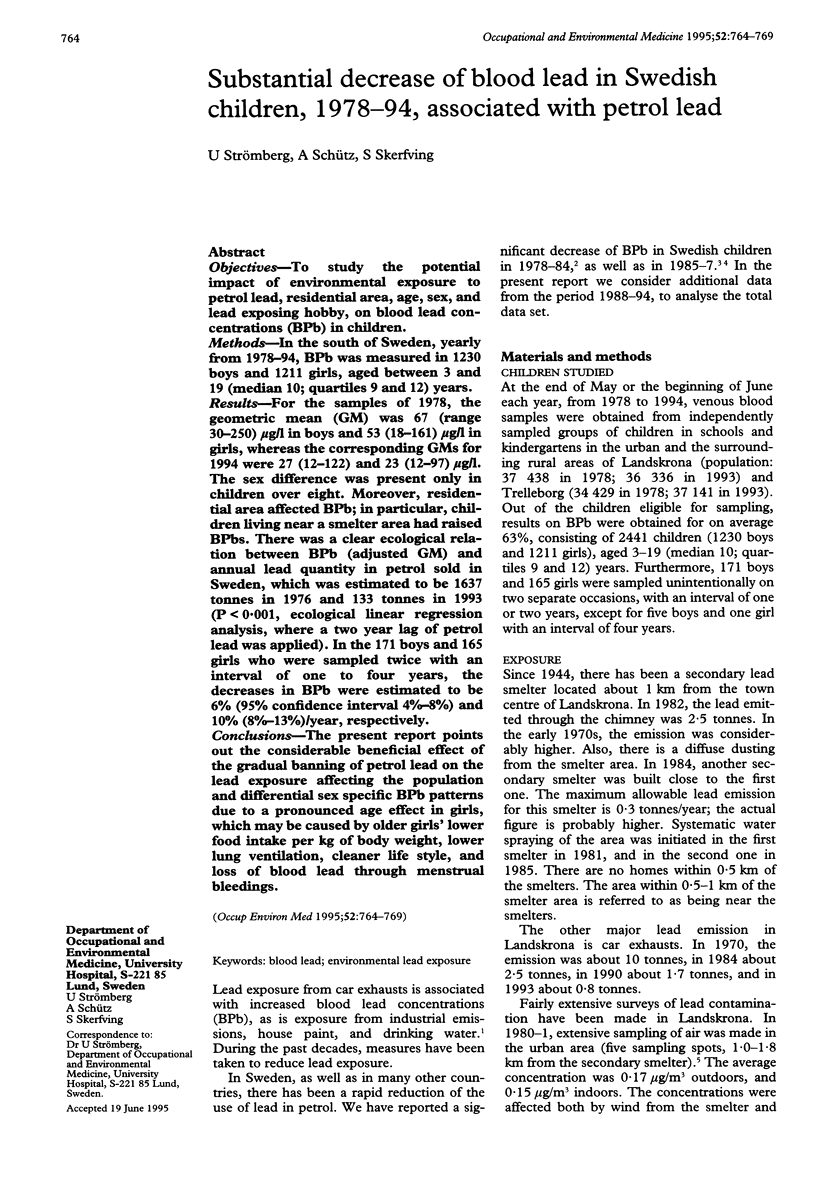
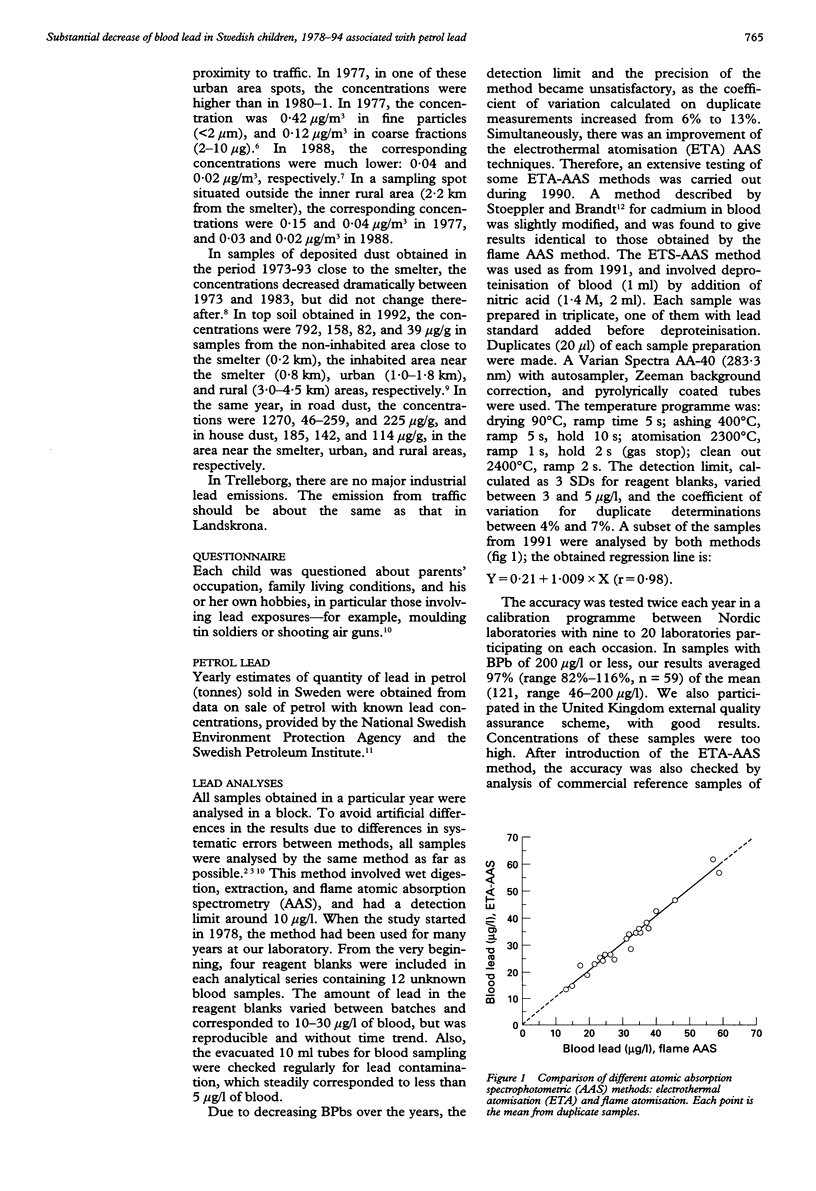
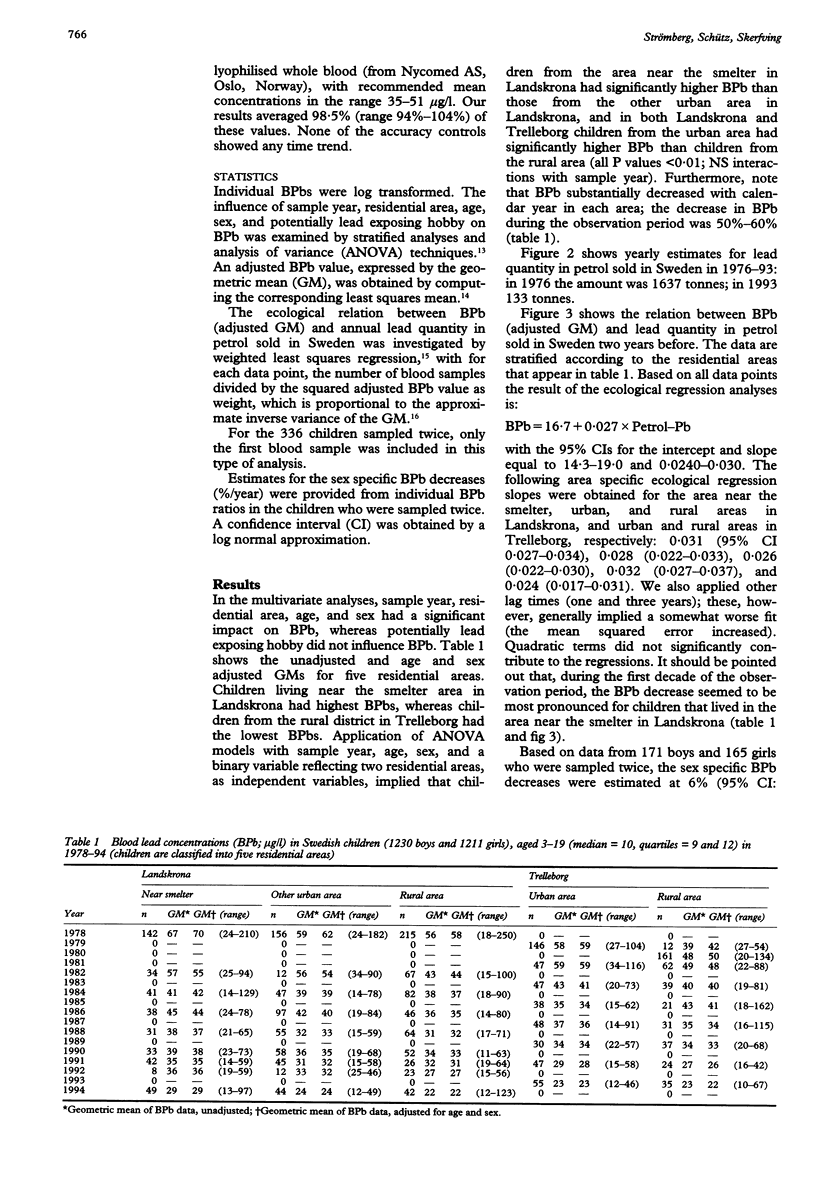
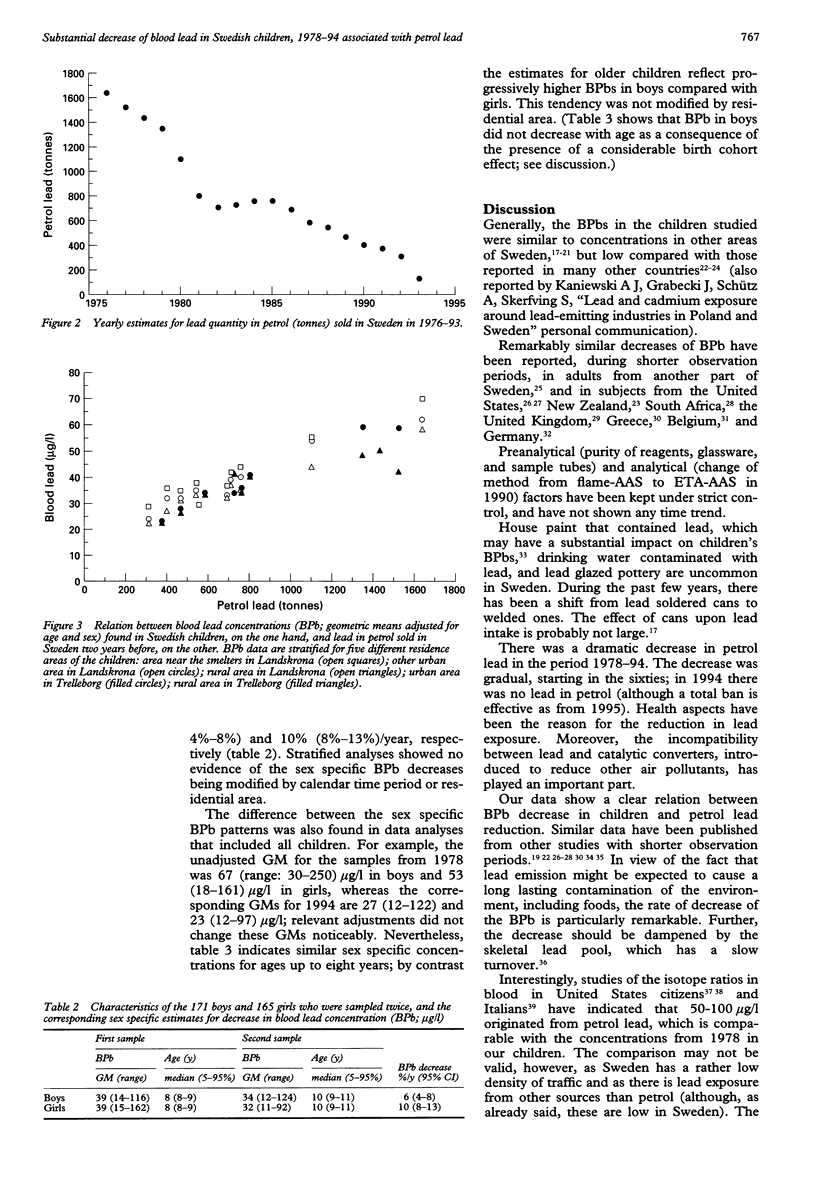
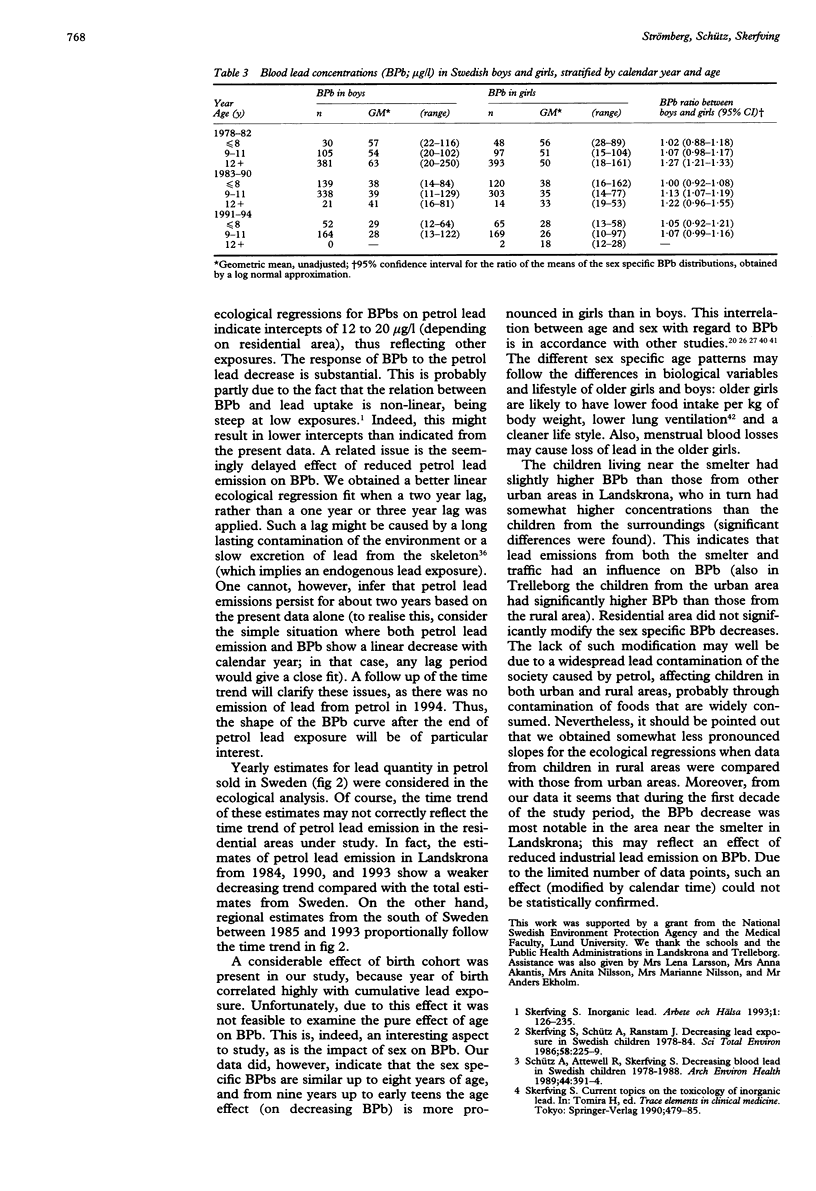
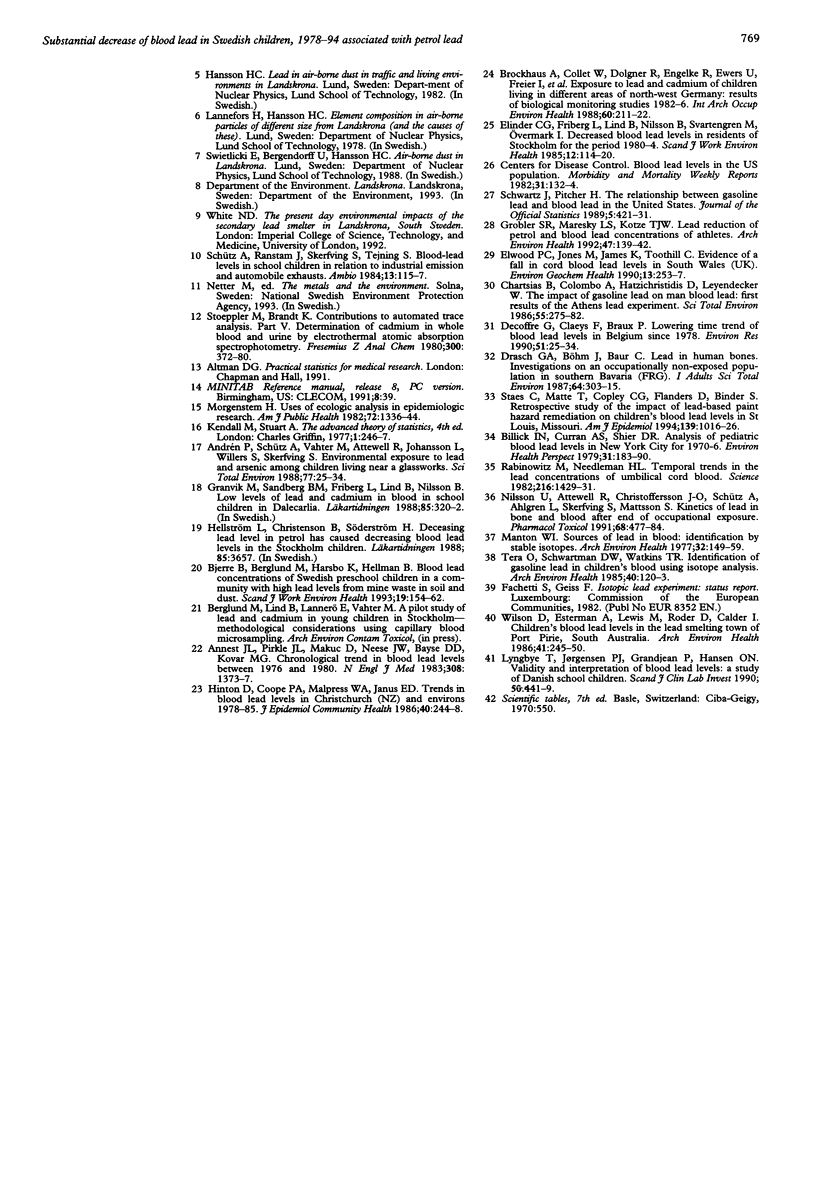
Selected References
These references are in PubMed. This may not be the complete list of references from this article.
- Andrén P., Schütz A., Vahter M., Attewell R., Johansson L., Willers S., Skerfving S. Environmental exposure to lead and arsenic among children living near a glassworks. Sci Total Environ. 1988 Nov 1;77(1):25–34. doi: 10.1016/0048-9697(88)90311-7. [DOI] [PubMed] [Google Scholar]
- Annest J. L., Pirkle J. L., Makuc D., Neese J. W., Bayse D. D., Kovar M. G. Chronological trend in blood lead levels between 1976 and 1980. N Engl J Med. 1983 Jun 9;308(23):1373–1377. doi: 10.1056/NEJM198306093082301. [DOI] [PubMed] [Google Scholar]
- Billick I. H., Curran A. S., Shier D. R. Analysis of pediatric blood lead levels in New York City for 1970-1976. Environ Health Perspect. 1979 Aug;31:183–190. doi: 10.1289/ehp.7931183. [DOI] [PMC free article] [PubMed] [Google Scholar]
- Bjerre B., Berglund M., Harsbo K., Hellman B. Blood lead concentrations of Swedish preschool children in a community with high lead levels from mine waste in soil and dust. Scand J Work Environ Health. 1993 Jun;19(3):154–161. doi: 10.5271/sjweh.1487. [DOI] [PubMed] [Google Scholar]
- Brockhaus A., Collet W., Dolgner R., Engelke R., Ewers U., Freier I., Jermann E., Krämer U., Manojlovic N., Turfeld M. Exposure to lead and cadmium of children living in different areas of north-west Germany: results of biological monitoring studies 1982-1986. Int Arch Occup Environ Health. 1988;60(3):211–222. doi: 10.1007/BF00378699. [DOI] [PubMed] [Google Scholar]
- Chartsias B., Colombo A., Hatzichristidis D., Leyendecker W. The impact of gasoline lead on man blood lead: first results of the Athens lead experiment. Sci Total Environ. 1986 Nov 1;55:275–282. doi: 10.1016/0048-9697(86)90186-5. [DOI] [PubMed] [Google Scholar]
- Drasch G. A., Böhm J., Baur C. Lead in human bones. Investigations on an occupationally non-exposed population in southern Bavaria (F.R.G.). I. Adults. Sci Total Environ. 1987 Jul;64(3):303–315. doi: 10.1016/0048-9697(87)90252-x. [DOI] [PubMed] [Google Scholar]
- Ducoffre G., Claeys F., Bruaux P. Lowering time trend of blood lead levels in Belgium since 1978. Environ Res. 1990 Feb;51(1):25–34. doi: 10.1016/s0013-9351(05)80180-x. [DOI] [PubMed] [Google Scholar]
- Elinder C. G., Friberg L., Lind B., Nilsson B., Svartengren M., Overmark I. Decreased blood lead levels in residents of Stockholm for the period 1980-1984. Scand J Work Environ Health. 1986 Apr;12(2):114–120. doi: 10.5271/sjweh.2169. [DOI] [PubMed] [Google Scholar]
- Grobler S. R., Maresky L. S., Kotze T. J. Lead reduction of petrol and blood lead concentrations of athletes. Arch Environ Health. 1992 Mar-Apr;47(2):139–142. doi: 10.1080/00039896.1992.10118768. [DOI] [PubMed] [Google Scholar]
- Hinton D., Coope P. A., Malpress W. A., Janus E. D. Trends in blood lead levels in Christchurch (NZ) and environs 1978-85. J Epidemiol Community Health. 1986 Sep;40(3):244–248. doi: 10.1136/jech.40.3.244. [DOI] [PMC free article] [PubMed] [Google Scholar]
- Lyngbye T., Jørgensen P. J., Grandjean P., Hansen O. N. Validity and interpretation of blood lead levels: a study of Danish school children. Scand J Clin Lab Invest. 1990 Jun;50(4):441–449. doi: 10.3109/00365519009091604. [DOI] [PubMed] [Google Scholar]
- Manton W. I. Sources of lead in blood. Identification by stable isotopes. Arch Environ Health. 1977 Jul-Aug;32(4):149–159. doi: 10.1080/00039896.1977.10667273. [DOI] [PubMed] [Google Scholar]
- Morgenstern H. Uses of ecologic analysis in epidemiologic research. Am J Public Health. 1982 Dec;72(12):1336–1344. doi: 10.2105/ajph.72.12.1336. [DOI] [PMC free article] [PubMed] [Google Scholar]
- Nilsson U., Attewell R., Christoffersson J. O., Schütz A., Ahlgren L., Skerfving S., Mattsson S. Kinetics of lead in bone and blood after end of occupational exposure. Pharmacol Toxicol. 1991 Jun;68(6):477–484. doi: 10.1111/j.1600-0773.1991.tb01273.x. [DOI] [PubMed] [Google Scholar]
- Rabinowitz M. B., Needleman H. L. Temporal trends in the lead concentrations of umbilical cord blood. Science. 1982 Jun 25;216(4553):1429–1431. doi: 10.1126/science.7089532. [DOI] [PubMed] [Google Scholar]
- Schütz A., Attewell R., Skerfving S. Decreasing blood lead in Swedish children, 1978-1988. Arch Environ Health. 1989 Nov-Dec;44(6):391–394. doi: 10.1080/00039896.1989.9935913. [DOI] [PubMed] [Google Scholar]
- Skerfving S., Schütz A., Ranstam J. Decreasing lead exposure in Swedish children, 1978-84. Sci Total Environ. 1986 Dec 31;58(3):225–229. doi: 10.1016/0048-9697(86)90201-9. [DOI] [PubMed] [Google Scholar]
- Staes C., Matte T., Copley C. G., Flanders D., Binder S. Retrospective study of the impact of lead-based paint hazard remediation on children's blood lead levels in St. Louis, Missouri. Am J Epidemiol. 1994 May 15;139(10):1016–1026. doi: 10.1093/oxfordjournals.aje.a116941. [DOI] [PubMed] [Google Scholar]
- Tera O., Schwartzman D. W., Watkins T. R. Identification of gasoline lead in children's blood using isotopic analysis. Arch Environ Health. 1985 Mar-Apr;40(2):120–123. doi: 10.1080/00039896.1985.10545901. [DOI] [PubMed] [Google Scholar]
- Wilson D., Esterman A., Lewis M., Roder D., Calder I. Children's blood lead levels in the lead smelting town of Port Pirie, South Australia. Arch Environ Health. 1986 Jul-Aug;41(4):245–250. doi: 10.1080/00039896.1986.9938340. [DOI] [PubMed] [Google Scholar]


